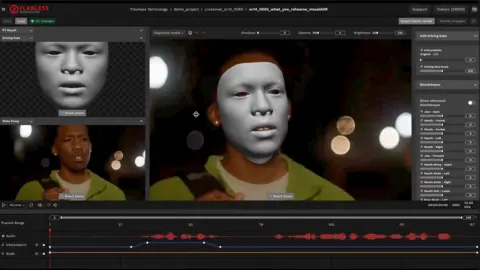Business
Will AI make language dubbing easy for film and TV?

Technology Reporter
 XYZ Films
XYZ FilmsFinding international films that might appeal to the US market is an important part of the work XYZ Films.
Maxime Cottray is the chief operating officer at the Los Angeles-based independent studio.
He says the US market has always been tough for foreign language films.
“It’s been limited to coastal New York viewers through art house films,” he says.
It’s partly a language problem.
“America is not a culture which has grown up with subtitles or dubbing like Europe has,” he points out.
But that language hurdle might be easier to clear with a new AI-driven dubbing system.
The audio and video of a recent film, Watch the Skies, a Swedish sci-fi film, was fed into a digital tool called DeepEditor.
It manipulates the video to make it look like actors are genuinely speaking the language the film is made into.
“The first time I saw the results of the tech two years ago I thought it was good, but having seen the latest cut, it’s amazing. I’m convinced that if the average person if saw it, they wouldn’t notice it – they’d assume they were speaking whatever language that is,” says Mr Cottray.
The English version of Watch The Skies was released in 110 AMC Theatres across the US in May.
“To contextualise this result, if the film were not dubbed into English, the film would never have made it into US cinemas in the first place,” says Mr Cottray.
“US audiences were able to see a Swedish independent film that otherwise only a very niche audience would have otherwise seen.”
He says that AMC plans to run more releases like this.
 Flawless
FlawlessDeepEditor was developed by Flawless, which is headquartered in Soho, London.
Writer and director Scott Mann founded the company in 2020, having worked on films including Heist, The Tournament and Final Score.
He felt that traditional dubbing techniques for the international versions of his films didn’t quite match the emotional impact of the originals.
“When I worked on Heist in 2014, with a brilliant cast including Robert De Niro, and then I saw that movie translated to a different language, that’s when I first realised that no wonder the movies and TV don’t travel well, because the old world of dubbing really kind of changes everything about the film,” says Mr Mann, now based in Los Angeles.
“It’s all out of sync, and it’s performed differently. And from a purist filmmaking perspective, a very much lower grade product is being seen by the rest of the world.”
 Flawless
FlawlessFlawless developed its own technology for identifying and modifying faces, based on a method first presented in a research paper in 2018.
“DeepEditor uses a combination of face detection, facial recognition, landmark detection [such as facial features] and 3D face tracking to understand the actor’s appearance, physical actions and emotional performance in every shot,” says Mr Mann.
The tech can preserve actors’ original performances across languages, without reshoots or re-recordings, reducing costs and time, he says.
According to him, Watch the Skies was the world’s first fully visually-dubbed feature film.
As well as giving an actor the appearance of speaking another language, DeepEditor can also transfer a better performance from one take into another, or swap a new line of dialogue, while keep the original performance with its emotional content intact.
Thanks to the explosion of streaming platforms such as Netflix and Apple, the global film dubbing market is set to increase from US$4bn (£3bn) in 2024 to $7.6bn by 2033, according to a report by Business Research Insights.
Mr Mann won’t say how much the tech costs but says it varies per project. “I’d say it works out at about a tenth of the cost of shooting it or changing it any other way.”
His customers include “pretty much all the really big streamers”.
Mr Mann believes the technology will enable films to be seen by a wider audience.
“There is an enormous amount of incredible kind of cinema and TV out there that is just never seen by English speaking folks, because many don’t want to watch it with dubbing and subtitles,” says Mr Mann.
The tech isn’t here to replace actors, says Mann, who says voice actors are used rather than being replaced with synthetic voices.
“What we found is that if you make the tools for the actual creatives and the artists themselves, that’s the right way of doing it… they get kind of the power tools to do their art and that can feed into the finished product. That’s the opposite of a lot of approaches that other tech companies have taken.”
 Natan Dvir
Natan DvirHowever, Neta Alexander, assistant professor of film and media at Yale University, says that while the promise of wider distribution is tempting, using AI to reconfigure performances for non-native markets risks eroding the specificity and texture of language, culture, and gesture.
“If all foreign films are adapted to look and sound English, the audience’s relationship with the foreign becomes increasingly mediated, synthetic, and sanitised,” she says.
“This could discourage cross-cultural literacy and disincentivise support for subtitled or original-language screenings.”
Meanwhile, she says, the displacement of subtitles, a key tool for language learners, immigrants, deaf and hard-of-hearing viewers and many others, raises concerns about accessibility.
“Closed captioning is not just a workaround; it’s a method of preserving the integrity of both visual and auditory storytelling for diverse audiences,” says Prof Alexander.
Replacing this with automated mimicry suggests a disturbing turn toward commodified and monolingual film culture, she says.
“Rather than ask how to make foreign films easier for English-speaking audiences, we might better ask how to build audiences that are willing to meet diverse cinema on its own terms.”
Business
Private sector data: Over 2 lakh private companies closed in 5 years; govt flags monitoring for suspicious cases – The Times of India

NEW DELHI: The government on Monday said that over the past five years, more than two lakh private companies have been closed in India.According to data provided by Minister of State for Corporate Affairs Harsh Malhotra in a written reply to the Lok Sabha, a total of 2,04,268 private companies were shut down between 2020-21 and 2024-25 due to amalgamation, conversion, dissolution or being struck off from official records under the Companies Act, 2013.Regarding the rehabilitation of employees from these closed companies, the minister said there is currently no proposal before the government, as reported by PTI. In the same period, 1,85,350 companies were officially removed from government records, including 8,648 entities struck off till July 16 this fiscal year. Companies can be removed from records if they are inactive for long periods or voluntarily after fulfilling regulatory requirements.On queries about shell companies and their potential use in money laundering, Malhotra highlighted that the term “shell company” is not defined under the Companies Act, 2013. However, he added that whenever suspicious instances are reported, they are shared with other government agencies such as the Enforcement Directorate and the Income Tax Department for monitoring.A major push to remove inactive companies took place in 2022-23, when 82,125 companies were struck off during a strike-off drive by the corporate affairs ministry.The minister also highlighted the government’s broader policy to simplify and rationalize the tax system. “It is the stated policy of the government to gradually phase out exemptions and deductions while rationalising tax rates to create a simple, transparent, and equitable tax regime,” he said. He added that several reforms have been undertaken to promote investment and ease of doing business, including substantial reductions in corporate tax rates for existing and new domestic companies.
Business
Pakistan’s Textile Exports Reach Historic High in FY2025-26 – SUCH TV

Pakistan’s textile exports surged to $6.4 billion during the first four months of the 2025-26 fiscal year, marking the highest trade volume for the sector in this period.
According to the Pakistan Bureau of Statistics (PBS), value-added textile sectors were key contributors to the growth.
Knitwear exports reached $1.9 billion, while ready-made garments contributed $1.4 billion.
Significant increases were observed across several commodities: cotton yarn exports rose 7.74% to $238.9 million, and raw cotton exports jumped 100%, reaching $2.6 million from zero exports the previous year.
Other notable gains included tents, canvas, and tarpaulins, up 32.34% to $53.48 million, while ready-made garments increased 5.11% to $1.43 billion.
Exports of made-up textile articles, excluding towels and bedwear, rose 4.17%, totaling $274.75 million.
The report also mentioned that the growth in textile exports is a result of improved global demand and stability in the value of the Pakistani rupee.
Business
Peel Hunt cheers ‘positive steps’ in Budget to boost London market and investing

UK investment bank Peel Hunt has given some support to under-pressure Chancellor Rachel Reeves over last week’s Budget as it said efforts to boost the London market and invest in UK companies were “positive steps”.
Peel Hunt welcomed moves announced in the Budget, such as the stamp duty exemption for shares bought in newly listed firms on the London market and changes to Isa investing.
It comes as Ms Reeves has been forced to defend herself against claims she misled voters by talking up the scale of the fiscal challenge in the run-up to last week’s Budget, in which she announced £26 billion worth of tax rises.
Peel Hunt said: “Following a prolonged period of pre-Budget speculation, businesses and investors now have greater clarity from which they can start to plan.
“The key measures were generally well received by markets, particularly the creation of additional headroom against the Chancellor’s fiscal rules.
“Initiatives such as a stamp duty holiday on initial public offerings (IPOs) and adjustments to the Isa framework are intended to support UK capital markets and encourage investment in British companies.
“These developments, alongside the Entrepreneurship in the UK paper published simultaneously, represent positive steps toward enhancing the UK’s attractiveness for growth businesses and long-term investors.”
Ms Reeves last week announced a three-year stamp duty holiday on shares bought in new UK flotations as part of a raft of measures to boost investment in UK shares.
She also unveiled a change to the individual savings account (Isa) limit that lowers the cash element to £12,000 with the remaining £8,000 now redirected into stocks and shares.
But the Chancellor also revealed an unexpected increase in dividend tax, rising by 2% for basic and higher rate taxpayers next year, which experts have warned “undermines the drive to increase investing in Britain”.
Peel Hunt said the London IPO market had begun to revive in the autumn, although listings activity remained low during its first half to the end of September.
Firms that have listed in London over recent months include The Beauty Tech Group, small business lender Shawbrook and tinned tuna firm Princes.
Peel Hunt added that deal activity had “continued at pace” throughout its first half, with 60 transactions announced across the market during that time and 10 active bids for FTSE 350 companies, as at the end of September.
Half-year results for Peel Hunt showed pre-tax profits jumped to £11.5 million in the six months to September 30, up from £1.2 million a year earlier, as revenues lifted 38.3%.
Peel Hunt said its workforce has been cut by nearly 10% since the end of March under an ongoing savings drive, with full-year underlying fixed costs down by around £5 million.
Steven Fine, chief executive of Peel Hunt, said: “The second half has started strongly, with the group continuing to play leading roles across both mergers and acquisitions and equity capital markets mandates.”
-

 Sports1 week ago
Sports1 week agoWATCH: Ronaldo scores spectacular bicycle kick
-

 Entertainment1 week ago
Entertainment1 week agoWelcome to Derry’ episode 5 delivers shocking twist
-

 Politics1 week ago
Politics1 week agoWashington and Kyiv Stress Any Peace Deal Must Fully Respect Ukraine’s Sovereignty
-

 Business1 week ago
Business1 week agoKey economic data and trends that will shape Rachel Reeves’ Budget
-

 Tech6 days ago
Tech6 days agoWake Up—the Best Black Friday Mattress Sales Are Here
-

 Politics1 week ago
Politics1 week ago53,000 Sikhs vote in Ottawa Khalistan Referendum amid Carney-Modi trade talks scrutiny
-

 Fashion1 week ago
Fashion1 week agoCanada’s Lululemon unveils team Canada kit for Milano Cortina 2026
-

 Tech23 hours ago
Tech23 hours agoGet Your Steps In From Your Home Office With This Walking Pad—On Sale This Week






